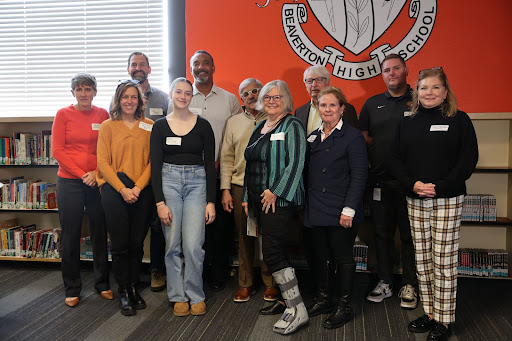District boundaries redrawn: Forecasting for Beaverton community and schools
As the District redraws its borders to alleviate overcrowding in schools, the community resists change.
For years, families in the Beaverton area have sent their children off to Beaverton High School. But next year, everything will change. Due to overcrowding in schools, new land was purchased south of the District to ease some of the tension, with a new high school—South Cooper Mountain—and elementary schools scheduled for the future.
“In order to balance out the populations in all of our high schools,” said district Superintendent Jeff Rose, “we have to go through a boundary shift to be able to open the new high school and create schools that aren’t over 90-100% capacity.”
The boundary change will leave much of Beaverton’s populace migrating to Southridge and its surrounding schools. Beaverton will receive students from Cedar Mills, West Slope, Cedar Hills, and from areas as far north as Sunset.
Freshman Abbey Ortensi doesn’t agree with the changes. “I’m in the new school, according to the boundaries…I don’t like it because I won’t be at Beaverton anymore. The new school will be really different.”
Fellow classmate, Riley Acott, agrees with Ortensi. “I don’t like [the changes] because I won’t be at Beaverton anymore, and I wish the [District Administrators] wouldn’t do it.”
Like Acott and Ortensi, many freshmen have grown accustomed to the spirit and tradition at Beaverton, and they don’t want to move to somewhere different.
“Some students from Westview will go to Sunset or Aloha, then some students from Sunset may have to go to Beaverton, and then from Beaverton to Southridge, from Southridge to the new high school. There is kind of this domino impact throughout the district,” Rose said.
The student bodies of almost every high school will be changing with the boundaries, meaning school communities may be vastly different in the coming years.
“I was surprised by how dramatically the District’s initial ‘springboard’ proposal shifted the existing school boundaries,” said Scott Reames, the president of the Beaverton Booster Club. “However, it’s important to remember that the springboard is a launching point for months of discussion, feedback, and negotiation that will ultimately, I believe, result in final boundaries that preserve more of Beaverton’s traditional ‘feeder’ schools.”
Unlike many others, Reames is positive about the changes. He believes that although they are inevitable, as a school, Beaverton can handle it and continue to grow as a strong community.
Meanwhile, people across the District have taken to the District’s website to leave all types of comments, ranging from sympathetic to judgemental to aggressive.
“I am not surprised by aggressive comments. I think that this is emotional and that people will say things aggressive in nature,” said Rose, acknowledging that public commenters have described the situation as “gerrymandering.” “I hope that over time, they will learn that month in, and month out, that they will realize, ‘Okay, I can see that they are doing their best to listen and make accommodations, and it’s change, and change will be hard.’”
Most of all, Rose wants to communicate to the concerned and angry people in the District that they are being heard.
Athletics plays an enormous role throughout high school, and with players skipping around the District, athletics may take a heavier blow.
“Generally. the athletic community is the most vocal,” said football coach Bob Boyer. “I would love to be able to carve out the [districts] that I don’t want and the ones that have all the football players in them, but it doesn’t work that way. We get what we get and we make the most of it from there.”
Unfortunately, athletics were not considered in the original springboard idea for the boundary shifts.
”The Boundary Adjustment Committee,” said Maureen Wheeler, Public Communications Officer for the District, ”will follow the criteria set forth; Availability of Space, Safety, Proximity to School, Transportation, Student Body Configuration, and Staffing Patterns. The Superintendent also proposed the following objectives: Minimize student transition and relieve current and future overcrowding with a five-year horizon.”
Though omitted in the first round of discussions, athletics may play a role if brought up by parents at the meetings made open to the public.
Students and teachers at Beaverton have conflicting opinions on whether the changes will be advantageous. Even the District is unsure of the outcome.
“There will be things that I think will be beneficial and some that will be hard for a while,” said Rose. “We just don’t know yet, and I am not going to pretend that this is easy. This has been proven to be one of the hardest things for schools to deal with: changes to their boundaries.”
As conversations abound at Beaverton regarding the boundaries, the consensus is that people are unhappy about the changes.
“Be fair and make sure that you are not disrupting too much. I get it. That’s where they put the school, but I don’t think that it is the best place in the world to put a school when you recut the boundaries,” said Boyer.
Like many, Boyer accepts that the boundaries will shift, but mostly wishes that the Beaverton community could stay unaffected. So far, the proposal for the boundary changes has been just that: a proposal. But though people may be angry, change will still occur.
“We will have completed a number of renovations and maintenance/improvement projects at most other existing schools [in the future],” said Wheeler.
Like Wheeler, Rose feels that the changes will benefit everyone in the District. “In five years, I think that we will definitely be in a better place than we are now.”
Coming out of this change, Beaverton High School is expected to be one of the schools most affected by the boundary changes.
“Changes are definitely coming to Beaverton High School, but regardless of the outcome of the boundary changes, Beaverton High School will continue to be a diverse, accepting, and forward-thinking community, powered by a strong administrative staff, excellent teachers, an involved parent and alumni base, and, most importantly, a student population that embraces the school’s rich traditions and is driven to excel,” Reames said.







